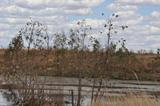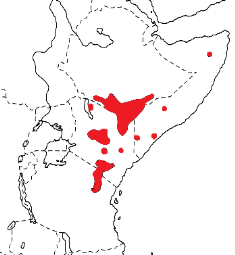Weaver species
Choose different species from drop-down list and press 'Go' button. See Full species list.Black-capped Social Weaver Pseudonigrita cabanisi
IUCN: Least concern Discovery: 079Categories: cooperative, acacias, Pseudonigrita+Philetairus,
News items about species
Discovery
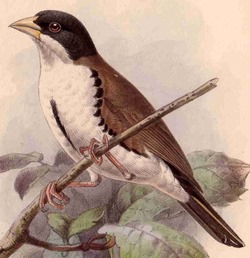
figure from Shelley (1888) 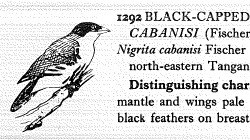
figure from Mackworth (1955) 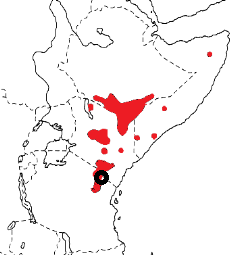
distribution, type locality circled IntroductionThe Black-capped Social Weaver was formally described jointly by Gustav A Fischer and Anton Reichenow, the latter being a German ornithologist and herpetologist.The Black-capped Social Weaver was collected by Gustav A Fischer, a German African explorer. He collected a large number of birds, including new species, in East Africa. Fischer settled as a physician in Zanzibar in 1876, from where he undertook expeditions to Tanzania and Kenya. His third trip started in late 1882 at Pangani on the Tanzanian coast and he followed the Pangani River upstream. When he reached the Pare Mountains in March 1883, he collected the type specimen of the Black-capped Social Weaver. He continued to Kilimanjaro and appears to have collected another specimen in the same area on his return. Fischer saw the Black-capped Social Weaver in small groups in acacia bushes and he also found small colonies of nests. The first illustration of the Black-capped Social Weaver was of the type, published by Shelley (1888). The second illustration for the species was a line drawing many decades later, in Mackworth (1955). Scientific citationNigrita cabanisi Fischer & Reichenow 1884, Journ. f. Orn., 32, p.54, Plains by Pare Mts.Meaning of namescabanisi, After Jean Louis Cabanis (1816-1906) German ornithologist and author.First English nameCabanis's Social-Waxbill (Shelley 1905).Alternate namesBlack-headed Sociable Weaver.CollectorGustav A Fischer.Date collectedMarch and July 1883.Locality collectedThe plains between the Pangani River and Pare Mountains.Type specimensThere are at least 2 types, one each in Berlin and Hamburg. |
The above is based on Weaver Wednesday 2, a weekly series about the discovery of each weaver species.
This species text first appeared as
Weaver Wednesday [196] - Discovery [79]: Black-capped Social Weaver on 2016-03-16
1. Basic biology
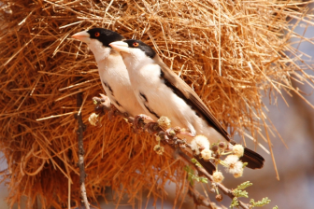
figure from PHOWN 714 Distribution.
The Black-capped Social Weaver is found through southern Ethiopia, Somalia, Kenya and northern Tanzania. There are no recognised subspecies.
Habitat. The Black-capped Social Weaver is very localized in dry thornveld, generally below 1300 m. It is sometimes found with Grey-headed Social Weavers, and also with Speckle-fronted Weavers. Food.
The Black-capped Social Weaver forages on the ground, feeding mainly on seeds, and sometimes insects, including grasshoppers. Non-breeding flocks may be nomadic.
Breeding. The Black-capped Social Weaver is monogamous and colonial, with 7-61 nests in a colony. The nest is bulky, built of thin, dry grass stems and not lined. The protruding ends of the grass stems make it look untidy; sometimes several nests are so close that they merge. Roosting nests have two entrances, and one is closed for breeding nests. Both sexes add material throughout the year. One nest weighed 211 g, and contained about 9300 grass stems. Nests are often at the end of slender branches, in colonies on isolated acacia trees at about 2 m height. The eggs (clutch 2-4) are white or pinkish, with brown and violet markings. lt is not known if both sexes incubate (as is the case in the Grey-headed Social Weaver). The Black-capped Social Weaver is a cooperative breeder and both parents, and some helpers, feed the young. |
The above is based on Weaver Wednesday, a weekly series about weaver species.
This species text first appeared as
Weaver Wednesday [6]: Black-capped Social Weaver on 2012-07-25
2. Breeding facts
| Pair bond Monogamous; thought likely to be co-operative breeder. Colonial Breeding season Feb-May; also Dec-Jan and Aug-Sept in Kenya Nest site placed c. 2 m above gromd in tree such as Delonix, Acacia mellifera, Acacia tortilis or tree euphorbia (Euphotbia), often near end of pendant branch, adjacent nests sometimes merging into apparent compound structure Nest building both sexes add material throughout year Colony size up to 60 nests in adjoining trees Clutch size 2-4 Egg colour white or pinkish, with brown and violet markings Egg size size 19 x 14 mm Incubation in captivity, young fed by breeding pair and additional adult Chicks and nestling period No information |
Breeding information based on Handbook of the Birds of the World, Vol. 15.
3. Photos of Weaver Nests
 Vm 28572 | 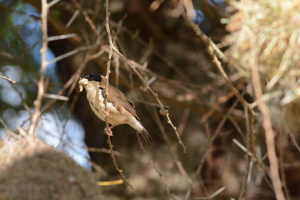 Vm 9892 | 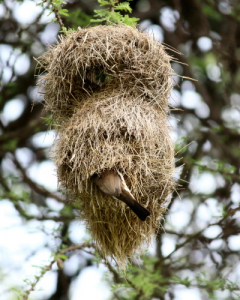 Vm 9618 | 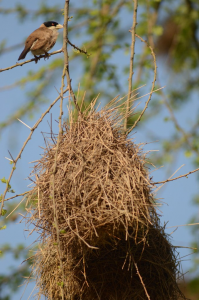 Vm 5112 |  Vm 2475 |  Vm 2028 |
Thumb-nails of most recent PHOWN records - click on one to see its full record
See all PHOWN records for this species here.
PHOWN (Photos of Weaver Nests) provides valuable info on breeding distribution and colony sizes of weavers.
You can contribute by registering and submitting photos at Virtual Museum webpage.
4. Breeding distribution
Google map showing distribution (For species with small ranges you need to zoom in at the correct area to see the range):
yellow blob - range of weaver species; read more about this here.
![]() - PHOWN records with photos
- PHOWN records with photos
![]() - PHOWN records with no photos (Nest Record Cards, other records)
- PHOWN records with no photos (Nest Record Cards, other records)
![]() - Birdpix records
- Birdpix records
![]() - comments on out of range records, or interesting records
- comments on out of range records, or interesting records
![]() - type locality
- type locality
CLICK on the marker on the map to see individual record details.
5. Range changes
Not South African speciesThe above is based on Weaver Wednesday 3, a weekly series about range changes in South African weaver species.
This species text first appeared as
n/a








